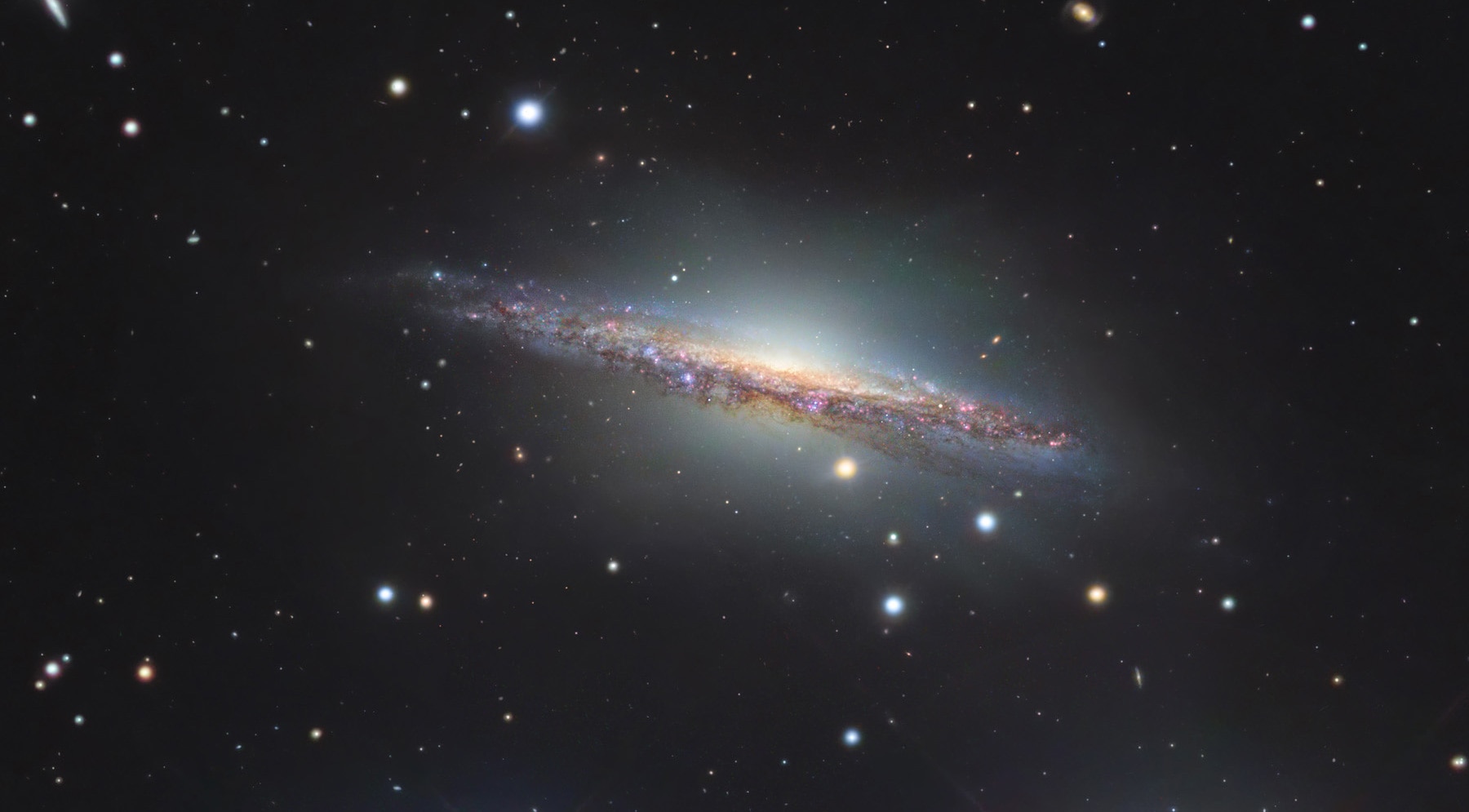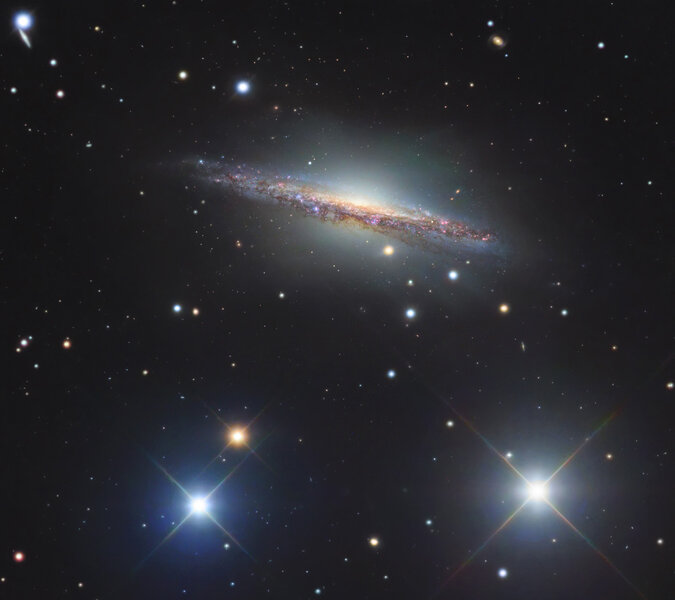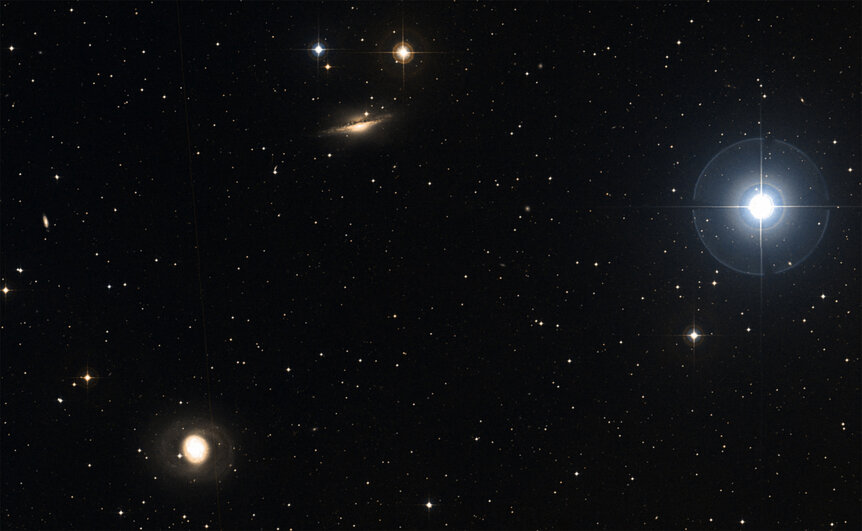Create a free profile to get unlimited access to exclusive videos, sweepstakes, and more!
A collision of art, science... and galaxies

A little over 50 million light-years away — just around the corner, at least on a cosmic neighborhood scale — lies the galaxy NGC 1055. It's a spiral galaxy, a vast disk of stars, gas, dust, and dark matter, seen nearly (but not quite) edge-on from our position on Earth.
It's gorgeous… but it's also weird. Both of these aspects are luminously obvious in a stunning image processed by Robert Gendler and Roberto Colombari:
Yow! Gendler and Colombari combined observations taken by the European Southern Observatory's Very Large Telescope, the National Astronomical Observatory of Japan's Subaru Telescope, and Gendler's own 51-centimeter telescope. The result is breathtaking.
And, well, weird. Seeing spiral galaxies nearly edge-on tends to downplay some irregularities in their arms; perspective foreshortens anomalies in the pattern… but it can accentuate deviations from the disk being flat. NGC 1055's disk is clearly odd: The edges are asymmetric and warped, indicating something is amiss. The tremendous glow surrounding it is also telling us that something is off about this galaxy; usually the central bulge is far more compact and well-behaved.
Maybe we need to take a step back. Sometimes it can help to get a bit of a wider-angle view, some context.
Aha! Now things are coming together. Literally. That galaxy to the lower left is M 77, another spiral, though this time face-on. M 77 is very nearly the same distance to us as NGC 1055, and because they're so close together in the sky that means they must be physically close together in space. Their exact distance from each other is hard to say, but they may be roughly half a million light-years apart, which is pretty close.
M 77 is what we call an active galaxy, with an intense amount of light pouring out of its nucleus (you can see that in the image above). All big galaxies have supermassive black holes in their centers, and active galaxies are super bright because their black holes are actively feeding: Material is pouring down into black hole. This material falls into a disk, and friction heats it up to millions of degrees. Anything that hot gets bright, which is why the core of M 77 is so luminous.
Many galaxies spend most of their lives quiescent, with their black holes barely eating anything at all (our Milky Way is like that). But if another galaxy happens to get too close, the gravitational interaction between the two can send octillions of tons of gas sleeting into the black hole. It's like flipping on a light switch… a very, very powerful light switch.
This whole thing looks very much like M 77 and NGC 1055 had a tryst in their recent past. That would explain M 77's activity, and could also explain lots of odd features in NGC 1055. The gravity from M 77 would have distorted NGC 1055's arms, for example.
A study of NGC 1055's structure indicates that the inner regions may be composed of three separate very thin disks of gas orbiting the center. That's unusual, since most galaxies only have two, and one of them at least is usually rather thick. However, a close pass by M 77 could have stirred up the gas in NGC 1055. The gas clouds would have collided with each other and rapidly settled down into a thin disk. Why there are three, though, isn't clear at all.
And there's another mystery. If you relax your gaze a little and look at the overall structure of NGC 1055 in the center, you can see a faint and very large X shape of light centered smack dab in the middle of it, like a treasure map. It's big, over 25,000 light-years in length! These kinds of things are seen sometimes in galaxies, and in fact our Milky Way has one. It's caused by the way stars orbit in the inner part of the bulge. They can form an elongated bar (like a gigantic Tic Tac) and create a peanut-shaped pair of lobes around the galaxy's center (the link above explains all this in detail).
But that's what's weird: A feature like this tends to be a little bit fragile. A near collision with another galaxy would collapse it! So perhaps the pass of M 77 wasn't too close. It was enough to cause some local chaos in each galaxy, but not enough to destroy this puffy X-marks-the-spot peanut-shaped feature. Or perhaps it happened long enough ago to let the peanut reform itself.
What gets me is that you can just see so much of this in these images! It takes a far deeper dive to understand just what's going on, of course, including observing them in multiple wavelengths (different kinds of light), taking spectra, and modeling the physics of what's going on. But still, the basic pieces are laid out in this image, just begging us to assemble them into a coherent picture.
And what I love beyond love is this: That picture is beautiful. Both scientifically and artistically. The Universe is a feast for our minds and our eyes. I will never not be hungry for more.
















